Open Source PBX Requirements
In my last post we covered the many options that are available for open-source telephony software. But open source telephony software isn’t all you need to consider.
You also need to take a look at the hardware you’ll be using with your open source PBX. And there are many factors that go into determining what type of hardware is needed in a VoIP application…
Open Source PBX Hardware Requirements
- Number of VoIP Users – This can be determined by the number of SIP extensions you will have in your solution.
- Maximum number of Simultaneous Calls – This number can differ from the number of VoIP users you have on your system. For instance, you may have 20 VoIP users on your system, but only have a total of 8 concurrent calls at any given time).
- Hard Drive Space – Are you a company that records many if not all call’s or allows VoIP users to archive VM messages a long period of time, if so, you may need a larger Hard Drive space to accompany this data.
- Redundancy from a data perspective – This requirement should apply to everyone. I don’t know of any customer that doesn’t want a RAID setup for the dual HD’s to essentially back-up system data and software in case one of the HD’s fails. RAID1 allows you to do this seamlessly as data and information is simply mirrored from a primary hard drive to a secondary hard drive for back-up purposes.
- Redundancy from a power requirement perspective – Dual hot swappable power supplies provide a redundant power source if 1 power supply fails. Even better, a replacement hot swappable power supply can be ordered and replaced as easy as sliding the bad power supply out and popping the new in and reconnecting the power source.
- PCI requirements – If you are going to connecting to the outside world via a T1 digital or PSTN analog trunk, one of the best solutions to use is a digital or analog telephony PCI card installed in your asterisk server. You will want to make sure that your server provides the necessary PCI or PCI Express bus on the motherboard, and then ensure you purchase the correct telephony card for your application.
- Space both inside the server chassis and rack space – If your VoIP application requires more than 2 PCI or PCIe telephony cards, it may be beneficial to go with a 3U server as it contains the necessary room inside the chassis to accompany these cards. Also full length PCI or PCIe cards may not physically fit in a smaller chassis such as a desktop and even some 1U servers. 3U servers also provide better ventilation for cooling as telephony cards, especially FXS do dissipate heat. It is suggested to keep your server running as cool as possible and heat could impact the processor, slowing everything down. Rack Space is another requirement to consider. Do you have the room in your server rack for a 3U (3 inches in height), if not maybe you should look at a 1U (1 inch in height) server. Keep in mind however, your PCI requirements when you make this decision.
- Motherboards and Chip Sets – Tested compatible motherboards and chipsets can be found below in our next section.
So now that you have a good grasp of server requirements to think about, below would be my recommendations as it relates to the requirements above.
Open Source PBX Hardware Recommendations
- Number of VoIP Users – Most open source telephony software applications allow you to add as many VoIP Users or SIP extensions as you wish. No hidden licensing fees or additional costs. The number of users may affect however, the maximum number of simultaneous calls you may have, so please read the next section that discusses this.
- Maximum number of Simultaneous Calls – A good number to go by is 23 concurrent calls. 23 concurrent calls require at least 1GB of RAM. 46 Concurrent calls requires about 2GB or RAM, and anything above that, you will be looking at 4GB of RAM. Keep in mind, it never hurts to have more RAM than not enough. This can directly affect your call quality and processing power of your server.

- Hard Drive Space – Most VoIP servers are running 80GB to 160GB SATA HD’s. If you are a company that does a high amount of call recording or VM storage archiving, you may want to consider 500GB to 1TB HD’s. Another option may be to store these recordings or messages on a separate network device such as a NAS that contains these high density HD’s or an FTP server, instead of storing everything on your server HD’s.
- Redundancy from a data perspective – Like I stated above, RAID1 from a data redundancy perspective is strongly suggested. In most RAID1 applications, you will setup 2 HD’s, a primary and secondary. You will setup a mirror which essentially copies all of the data from the primary HD to the secondary HD. In a situation where a HD fails, you have a full backup on your second HD, and will minimize server down-time.
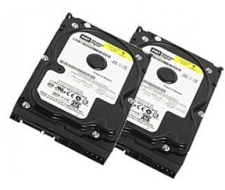
- Redundancy from a power requirement perspective – Let’s face it, power supplies fail. If your server is only running from a single power source, and it fails, you physically need open your server, and replace it or worse yet, replace the whole server. With a redundant power supply option, if one fails, your server is not affected and will continue to remain in production on a single power source, until you can replace the failed unit. In most cases, these are also hot-swappable, and are replaced as easy as “sliding in a new dresser drawer”.
- Dual Redundant Hot Swappable Power Supplies
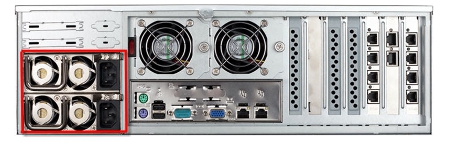
- Single Power Supply

- PCI requirements – Many server motherboards contain PCI and/or PCI Express slots. As it relates to PCI, you will want to keep the following in mind. PCI slot types, 5 volt vs. 3.3V, 32 bit vs. 64 bit, 33 Mhz or higher. Some PCI telephony manufacturers such as Sangoma and Rhino are backwards compatible on both their analog and digital PCI card offerings. That means they will work in any 3.3v or 5v situation. Digium, on the other hand, has backwards compatibility on their analog PCI card series, but their Digital cards are segmented between 3.3v and 5v requirements. Here is a good look at these PCI types as it relates to a server motherboard:
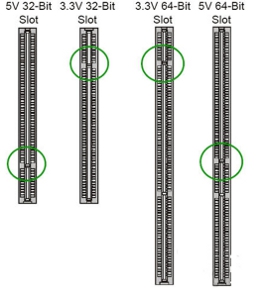 With PCIe, you don’t have to worry about voltage, but you will want to make sure the PCIe bus meets any of the following types below:
With PCIe, you don’t have to worry about voltage, but you will want to make sure the PCIe bus meets any of the following types below: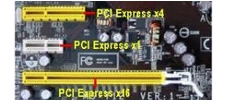
- Space inside the server chassis – Servers come in many shapes in sizes. The most common telephony servers consist of a 1U, 3U, or desktop mini appliance which is about the size of an Xbox. 1U and 3U chassis are characterized by how much rack mount space the take up. In relation to this, a 1U server is about 1Inch in height and a 3U server is about 3 inches in height. If you have the space, a 3U server is always suggested as most 3U servers have more PCI and/or PCIe slots available on the motherboard as well as physical slots on the chassis itself. This will permit you to use up to 6 analog telephony cards or full length telephony cards without the installation hassle you may have on smaller chassis such as 1U or Mini appliances. 1U servers usually facilitate up to 2 telephony PCI or PCIe cards with use of a PCI riser card and expansion.
- 3U
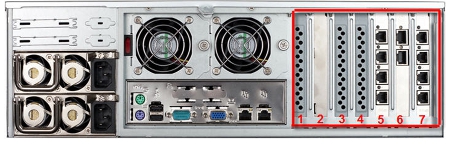
- 1U

- Asterisk and Open-source compatible motherboards – Here are a very detailed list of compatible asterisk Motherboards that have been fully tested. The below information source is from www.voip-info.org , which is one of the best VoIP resources available to you.
- Production Tested Compatible Server boards (64bit 3.3v)
-
- Dell
- WARNING – many Dell motherboards use the e1000 gigabit ethernet chipset, which has been known to cause random locksup – if you plan on using a Dell server, disable the onboard controller and purchase an addon ethernet card.
- Dell PowerEdge 1750
- Dell PowerEdge 2650
- Dell PowerEdge 2850 – When using the 2800 or 2850 server you will find they don’t ship with internal molex connectors. If you expect to be using a card such as the Digium TDM2400P and FXS modules then you will need internal molex connectors to power the FXS modules. You can order Item number G2536 for the 2800 or H2188 for the 2850 from dell and this connection will provide you with internal molex connectors. The item description is listed as “ASSY;CBL;PWR;PBAY;2DROP;PE2800”
- Dell Poweredge 750 (TE110P) Kernel 2.6.9, must use SMP kernel for APIC and X Windows not running, otherwise frame slips occur
- HP
- Compaq ProLiant DL380 G3
- HP DL320 (TE410P, TE110P) Kernel 2.6.5, 2.6.9 uniprocessor and SMP kernel
- IBM
- Intel
- Tyan
- Tyan Tomcat i720 S5112
- Tyan 7500i(S2721)
- Tyan Thunder i7501 Pro (S2721-533)
- Tyan Trinity GC-SL (S2707)
- Tyan GX15 B2723T15/B2723T15M
- Dell
-
- Supermicro
- Supermicro 7043A-ib, 614H-Xi, kernel 2.6.9 uniprocessor and Supermicro 6014H-X8 kernel 2.6.9 SMP – T100P, Sangoma A101, 102, and A104
- Supermicro PDSME, Intel E7230 chipset, Dual LAN, 2x 64-bit 133MHz PCI-X, 2x 64-bit 100MHz PCI-X, Sangoma A200D, 3ware 8006-2LP SATA RAID 1, kernel 2.6.9 SMP
- Unknown
- 7500i Systems
- Crystal CS100 with single PIV SBC running kernel 2.6 and a single T100P – Asterisk 1.0 stable
- Supermicro
-
- Production Tested Compatible Server boards (64bit 3.3v)
Also did you know that VoIP Supply offers provisioning services for your new VoIP system which covers installation of any telephony PCI or PCIe card, creation of SIP extensions on the PBX, registration of all phones to the PBX via their extension info, and PBX professional prompts services with a fully customizable IVR.
4 Comments
Very interesting an informative, but you have not said your recommendations on processor, (Atom, Core2 etc). Also would be interested in your thoughts on 64bit or 32bit Linux for Voip?
@derek
Good Point, most of the time, the motherboard being used will deliniate the type of processor you will use. We see most Server platforms running on Intel chipsets such as the Intel Dual Core, Core2 Duo, and Dual Core Atom ranging anywhere from 1.6 GHz to 2.4 GHz processing power. In terms of 32 bit vs 64bit, most systems are running the 32 bit version. 64 bit versions, in my experience, have caused some headaches as it relates to compatiblity. If I were to talk to a customer who was bulding their own asterisk server, I tend to steer them into a 32 bit solution. Also, there are not many noticable gains in performance as it relates to most VoIP deployments on 64 bit. You may notice a gain in performance when deploying an asterisk solution supplying a couple of hundred users, but I have personally seen deployments of 150 users with dual t1 (46 concurrent calls), being handled fine on a 32 bit system running 2GB of RAM on Core2 Due processor at 2.4 GHz. Its a very opinionated topic, in my mind 32 bit gets the job done in most cases.
Hello, I feel little confused about choosing to use either an FXO or an FXS adpater. What I need to achieve is use my Fixed Wireless Terminal Phone with my VOIP software on my system such that I and other users of the VOIP PBX network can initiate external calls on my VOIP software through the phone.
Please bear in mind that the phone box is a fixed CDMA phone box supplied by the phone company and it has always been working independently on its own for making external calls.
From my limited understanding, I think its just an FXS adpater that I need but I am not sure about this, please advise … ???
well thank you so much for enlightening, we have installed very many desktop computers with over 80 extensions we have not experienced any problems you also forgot to mention that there now gateways which don’t have to be installed on pci so relieving that burden. You don’t need an extraordinary PC to use on voip